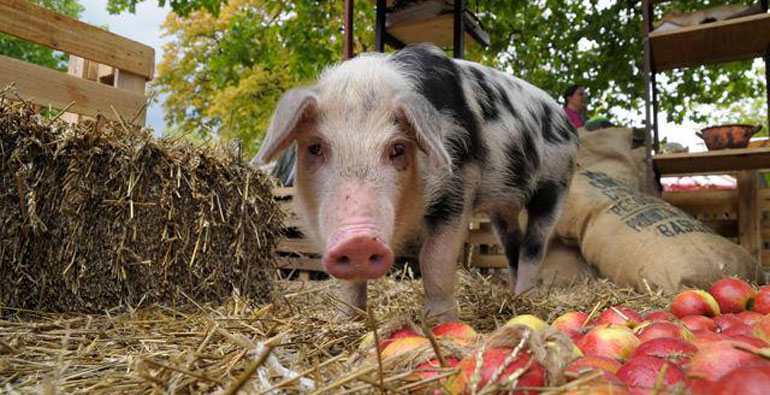The Porkhouse
Sjef Meijman & Elles Kiers
PeerGrouP is based in the North of the Netherlands, in a rural area. Their work is usually site specific and site generic. A field, a big coaster or a whole village can be their performance site; they hardly ever perform in theatre buildings. Instead of starting with a concept for a performance, the research starts with a fascination. During the research phase the results will be presented regularly to the people connected to the site. PeerGroup searches for artistic ways to do this; they create something tangible to share with the inhabitants. With the reactions to these provisional presentations, their search query can be specified and refined.
The pig-house is a project by Sjef Meijman, a visual agrarian (a mix of an artist and a farmer) and Elles Kiers, a visual artist and a chef. Their mission is to raise awareness about the origins of food and the way people deal with the locus of what they eat. Next to that, they recognized that local food production could have a positive effect on sustainability, health and social cohesion. Being aware of these two insights, they felt the need to share and visualize this through storytelling. The project they designed under the name ‘Het Varkenshuis’ (the pig-house) was set up in three locations in the Netherlands: One in the city of Rotterdam, one in Tilburg – the province where the most pigs in the Netherlands can be found -and one in Annerveenschekanaal – a place in the peat colonies of Drenthe. For this case study we will focus on one of the projects in particular namely the pigs ‘Arie’ and ‘Japie’ of Katendrecht, Rotterdam.

The process
Step 1: Location
Urban agriculture organisation ‘Rotterdamse Oogst’ invited the pig-project of location theatre company PeerGrouP to Rotterdam. Rotterdam Oogst focuses on the roots of the inhabitants of Rotterdam by refreshing the love for local food and drinks. They too acknowledge the benefits of local food production for sustainability, health and social cohesion. Especially in a city that sometimes lacks the latter. The area ‘Katendrecht’ in Rotterdam has developed from a so-called bad neighbourhood that even taxi drivers tended to avoid to a district now inhabited mostly by highly educated families with an above average income mixed with lower income families living in social housing. This caused for a socially dispersed neighbourhood lacking social cohesion. Therefore, bringing in the pig project by PeerGroup was considered a great idea to bridge the gap between the constructed differences in the area.
Step 2: Building the site
Two pigs named ‘Arie’ and ‘Japie’ (locally recognized names) were transferred to an empty lot in the neighbourhood. This lot was designed with the help of artists and was surrounded by an intricate wooden fence. The home for the pigs was created with the help of neighbours and volunteers. This marked the start of a sight for play, fun, awareness, connection and sharing.
Step 3: Engaging the public
Twenty-eight different people from the neighbourhood were given the task of taking care of the pigs. The pigs became a real attraction and their house a meeting place for a diverse group of people from the area. Children from different backgrounds brought their parents to meet at the sight. From the start it was no secret that the pigs would eventually be slaughtered however this was not something that was widely advertised. It was important that people could come and enjoy the pigs regardless of weather they knew they would end up on a plate in the near future.
The results
There are so many different results in relation to this project that it is hard to measure. For example, the awareness that was raised by many about their food and the lives of pigs is immeasurable. What was interesting is that eventually, a few people that knew about the slaughter got upset and started a petition to prevent the slaughter from happening. Over 2500 signatures were gathered and presented to the PeerGroup. The slaughter was out of the question since an intrinsic part of the project was to make people more aware and familiar with the origin of their food. The ultimate goal was to provide the opportunity for a diverse group of people to share a responsibility for the lives of two pigs and ultimately ones own food together as a group, creating social cohesion and a collective resulting in a festive dinner where the whole of the pigs would be consumed.
The ultimate question
How does this case demonstrate ways in which artists can support the global transformation towards a sustainable future?
The benefits of local food production are undeniable. This project brings to life the lost information and lack of awareness of people regarding the origin of their food. Next tot that it required active participation of a diverse group of people, creating social cohesion and community in a disconnected area. It did not only show the lives and reality of a pigs life waiting to be slaughtered but it also created an awareness of our current food industry, animal well-being and consumption behaviour. All of these things are extremely relevant in obtaining the global transformation towards a sustainable future. Especially in an era where a growing group of children believes chocolate milk comes from brown cows and have absolutely no clue bananas grow on plants.
